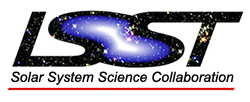LSST Solar System Science Collaboration
In a single visit, LSST could detect up to 5000 moving objects! Over its 10 year lifespan, LSST could catalog over 5 million Main Belt asteroids, almost 300,000 Jupiter Trojans, over 100,000 NEOs, and over 40,000 TNOs. Many of these objects will receive 100s of observations in multiple bandpasses. This amounts to increases of at least 10x the known population, with similar increases in the number of objects with enough data to generate lightcurves and colors.
If you are interested in joining the LSST Solar System Science Collaboration (SSSC) head to our dedicated website for further details including our membership application form.
